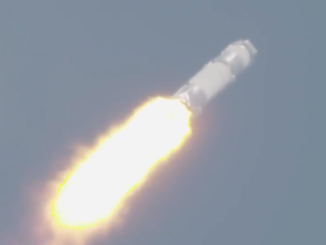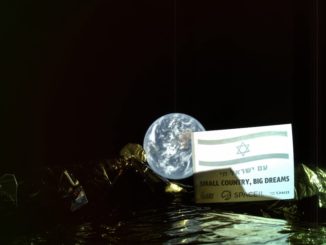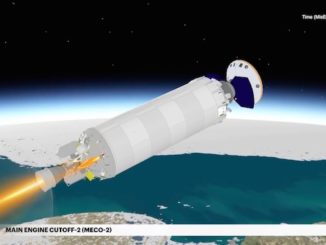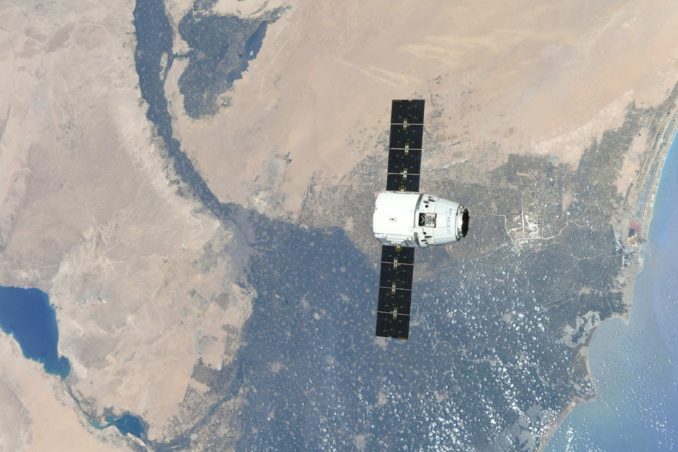
A commercial cargo carrier owned and operated by SpaceX pulled into port at the International Space Station on Monday, three days after launching from Cape Canaveral with a NASA Earth science instrument, a spare hand for the lab’s Canadian robotic arm, and an AI-powered helper bot for the research lab’s six-person crew.
Completing a high-flying cargo delivery with a leisurely laser-guided final approach, the Dragon spacecraft arrived at the space station at 6:54 a.m. EDT (1054 GMT) Monday as the lab’s robotic arm grasped the supply ship.
The link-up occurred as the International Space Station and Dragon cargo freighter soared 256 miles (412 kilometers) over Quebec, both speeding around Earth at a velocity of 5 miles (8 kilometers) per second.
“Houston, station, capture complete,” radioed astronaut Ricky Arnold. “Go for post-capture reconfiguration. Looking forward to some really exciting weeks ahead as we unload the science and get started on some great experiments.”
Ground controllers commanded the robotic arm to move the Dragon capsule to a berthing port on the station’s Harmony module, where a series of latches and 16 bolts closed create a firm connection between the outpost and the visiting supply ship around three hours later.
SpaceX’s Dragon capsule joins a Cygnus commercial supply ship from NASA’s other cargo transportation provider, Northrop Grumman, berthed at the nearby Unity module.
The Dragon cargo freighter launched Friday from Cape Canaveral on top of a Falcon 9 rocket. Its arrival at the space station Monday marked the second visit of the same capsule to the orbiting research complex, following a cargo delivery mission in July and August of 2016.
SpaceX refurbished the spacecraft’s pressurized compartment and flew it again.
SpaceX has a contract with NASA worth $3.04 billion for 20 resupply missions to the International Space Station. The mission that reached the research lab Monday was the 15th under that contract, including one flight that suffered a launch accident in June 2015.
NASA has awarded SpaceX a follow-on contract for a minimum of six additional resupply missions beginning in 2020, and a $2.6 billion deal to complete development of an upgraded crew-rated version of the Dragon spacecraft, which could fly its first unpiloted demonstration mission to the space station later this year.
SpaceX says it intends to fly the rest of its cargo missions under the first contract, which runs through early 2020, with reused Dragon capsules. After 2020, the company’s resupply flights will fly aboard the same “Dragon 2” vehicle design being developed for astronaut crews, replacing seats and cockpit controls with cargo accommodations.
Astronauts planned to open hatches leading to the Dragon spacecraft Tuesday, then begin unpacking the ship’s pressurized cabin.
The mission delivered 5,946 pounds (2,697 kilograms) of equipment, experiments and provisions to the orbiting research laboratory. About 3,774 pounds (1,712 kilograms) of that tally were carried inside Dragon’s internal cabin, including:
- 2,718 pounds (1,233 kilograms) of scientific investigations
- 452 pounds (205 kilograms) of crew supplies
- 392 pounds (178 kilograms) of vehicle hardware
- 139 pounds (63 kilograms) of spacewalk equipment
- 46 pounds (21 kilograms) of computer resources
- 27 pounds (12 kilograms) of Russian hardware
The cargo loaded inside Dragon include mice to be examined by scientists upon return to Earth. Researchers will study the effects of microgravity on microorganisms in the animals’ gastrointestinal tracts.
There is also an experiment aboard the Dragon cargo capsule which will help scientists study how algae grows in space. Algae could provide basic nutrition and help absorb carbon dioxide on future space missions, and algae oils could reduce the adverse effects of cosmic radiation on humans.
European Space Agency astronaut Alexander Gerst, who launched earlier this month to begin a half-year on the space station, is also getting a talking assistant enabled by artificial intelligence.
Known as CIMON — short for Crew Interactive Mobile Companion — the robot will help Gerst complete tasks, conduct experiments, and repair and upgrade components inside the space station.
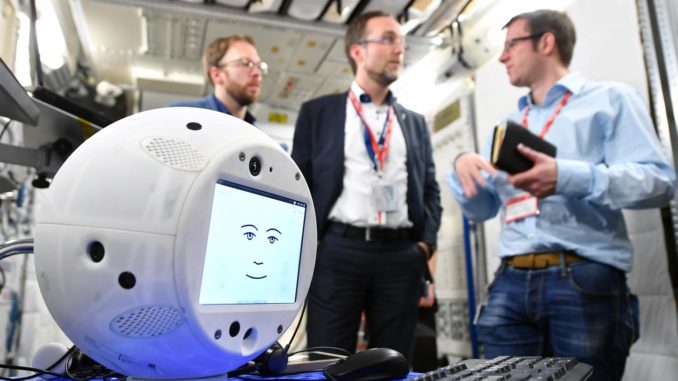
“CIMON a free-floating artificial intelligence, and when he will be activated, this is kind of a historical moment,” said Christian Karrasch, CIMON’s project lead at DLR, the German Aerospace Center. “We are very happy that CIMON will be the first artifical intelligence in space.
“For us, this is a piece of the future of human spaceflight. If you go out to the moon or to Mars, you cannot take all (of) mankind and engineers with you, but with an artifical intelligence, you have, instantly, all the knowledge of mankind,” Karrasch said.
Developed in partnership between DLR, Airbus Defense and Space, and IBM, CIMON is a spherical device about the size of a medicine ball. The entire structure of CIMON, primarily metal and plastic, was 3D-printed, according to Airbus.
Robots like CIMON could help space crews do their work more efficiently, improve safety, minimize crew stress, and help the public better understand spaceflight, according to project officials.
CIMON’s “neural” AI network and ability to learn, along with human-like characteristics such as a face and voice, will make it more of a companion than just an experiment to Gerst and other station crew members, officials said.
The AI-enabled helper was paired with Gerst, a German-born astronaut, using voice samples before his flight. That means CIMON will best communicate with him, but officials said anyone could work with the robot.
“If Alexander Gerst has certain questions to the experiment he’s working on, CIMON has quite keep knowledge on that experiment, so he can really get inside the experiment, and he can ask questions that are beyond the procedure,” said Philipp Schulien, an engineer on CIMON from Airbus.
CIMON learns with the help of IBM Watson AI technology.
“During the times when there is connectivity, all the communications go back through the cloud,” said Bret Greenstein, IBM’s global vice president of Watson and Internet of Things offerings. “So all the AI work is being processed at the cloud, actual language, all the training and the tailoring we did, happens in the cloud, which also means we can enhance it from the Earth anytime, and make it smarter constantly to help Alexander and the team to use it.”
Kirk Shireman, NASA’s space station program manager, said astronaut crews traveling deeper into the solar system will need to be more autonomous due to the communications delays inherent in such journeys.
“You can think of all of human knowledge, you might need to access parts of that,” Shireman said. “So having AI, and having that knowledge base and the ability to tap into it in a way that’s useful for the task that you’re doing, is really critical for having humans farther and farther away from the planet.”
Several CubeSats were also carried inside Dragon’s pressurized module for deployment outside the space station in the coming months. Three of the nanosatellites are part of the Biarri program, a partnership between defense authorities in the United States, Australia, the United Kingdom and Canada.
Three CubeSats developed under the auspices of the Birds program, led by the Kyushu Institute of Technology in Japan, were also delivered to the space station Monday for later deployment. The Birds CubeSats inside Dragon were built by students in Bhutan, Malaysia and the Philippines.
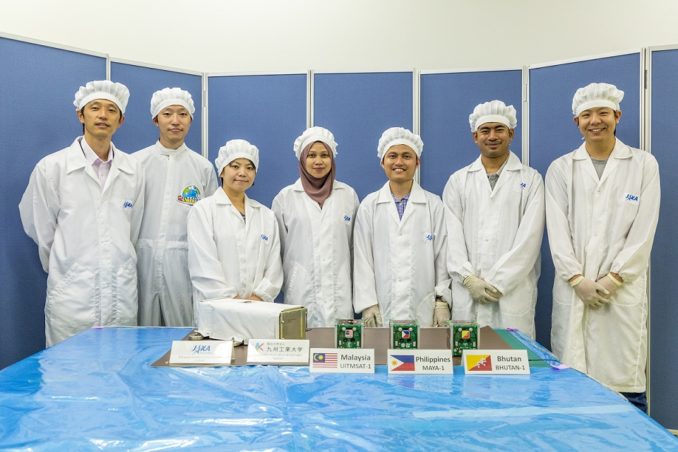
In sum, the cargo mission will help enable 27 scientific experiments on the space station, according to David Brady, the International Space Station’s assistant program scientist at NASA’s Johnson Space Center in Houston.
Fresh food, including crab, lobster and maple-smoked salmon, pouches of strong coffee from Death Wish Coffee, an iPad Air, and spacesuit gloves are also among the items stowed inside the Dragon spacecraft.
The equipment launched to the space station inside the Dragon’s trunk included a spare Canadian-built latching end effector for the research lab’s robotic arm, plus a 1,213-pound (550-kilogram) instrument developed by NASA’s Jet Propulsion Laboratory to be mounted outside the station’s Japanese Kibo lab module to measure the temperature of plants from space.
The spare latching end effector, or hand, for the robotic arm will be stored outside the space station, ready to replace one of the arm’s two end effectors with the help of spacewalking astronauts, if needed.
Astronauts replaced both hands of the robotic arm in a series of spacewalks late last year and earlier this year. Both latching end effectors showed signs of aging and wear-and-tear after nearly 17 years on the space station, and the replacements left the station without a spare hand for the arm, also known as Canadarm 2.
“It’s a critical system,” said Ken Podwalski, the Canadian Space Agency’s space station program manager. “We always want to be able to protect for a failure.”
The robotic arm is vital for the space station to receive cargo deliveries by SpaceX’s Dragon spacecraft, Northrop Grumman’s Cygnus cargo carrier, and Japan’s HTV supply ship. It is also used to move astronauts around the space station on spacewalks, and for transferring experiments and other equipment around the exterior of the nearly million-pound science outpost.
Canadarm 2 is Canada’s primary contribution to the space station. It uses the latching end effectors to inchworm between multiple host adapters outside space station module and on the station’s truss backbone, and the arm’s hands are capable of routing data, video and electrical power.
“Overall, I would dare say that we’ve gotten exceptional performance out of our space robotics, just because (we’re) 17 years into the game for a system that was designed for a 10-year operational life — and 15 years on orbit — with the very few issues that we’ve had,” Podwalski said.
“I think our biggest problems have really been about cameras. We’ve changed a number of cameras. We’ve got new cameras in the works, and those are actually very nice because we can actually change them out robotically,” he said. “So that’s a case where we’re using our own robots to fix our own robots. It’s kind of the ideal scenario.”
The Ecosystem Spaceborne Thermal Radiometer Experiment on Space Station, or ECOSTRESS, will measure heat energy coming off Earth’s surface. The temperature measurements will tell scientists about the health of the plants, how much water they are using, and the resiliency of crops to extreme conditions like heat waves and droughts.
“When a plant is so stressed that it turns brown, it’s often too late for it to recover,” said Simon Hook, ECOSTRESS principal investigator at JPL. “But measuring the temperature of the plant lets you see that a plant is stressed before it reaches that point.”
Developed under a cost cap of $30 million, the ECOSTRESS instrument is a pathfinder for future missions, and it will collect data from its mounting fixture outside the space station for about one year.
“ECOSTRESS will allow us to monitor rapid changes in crop stress at the field level, enabling earlier and more accurate estimates of how yields will be impacted,” said Martha Anderson, an ECOSTRESS science team member with the U.S. Department of Agriculture in Beltsville, Maryland. “Even short-term moisture stress, if it occurs during a critical stage of crop growth, can significantly impact productivity.”
The thermal sensitivity of ECOSTRESS will also make it useful for detecting and studying hotspots, such as wildfires and volcanoes.
The Dragon spacecraft will depart the space station Aug. 2 and return to a splashdown in the Pacific Ocean with nearly two tons of equipment, cargo and research specimens for analysis by engineers and scientists on the ground.
The Dragon capsule will come back to Earth with one of Canadarm 2’s old latching end effectors, which will be inspected and repaired by Canadian engineers for an eventual re-launch to the space station.
After Monday’s arrival of SpaceX’s Dragon capsule, the space station crew will prepare for the launch and docking of a Russian Progress resupply and refueling freighter July 9. The Progress MS-09 spacecraft is set to blast off from the Baikonur Cosmodrome in Kazakhstan at 5:51 p.m. EDT (2151 GMT) next Monday.
The Russian cargo carrier will attempt the shortest rendezvous ever tried at the space station, with docking scheduled less than four hours later at 8:39 p.m. EDT (0039 GMT on July 10).
The Cygnus supply ship already at the space station is scheduled to conduct a short re-boost of the research lab’s orbit July 12, the first time such a maneuver has been attempted by a U.S. commercial cargo vehicle. Three days later, on July 15, the Cygnus spacecraft is set to depart the space station loaded with trash for disposal during a destructive re-entry over the Pacific Ocean.
But the Northrop Grumman-owned cargo craft will first climb into a higher orbit to release multiple commercial CubeSats carried in a deployer outside the vehicle.
Email the author.
Follow Stephen Clark on Twitter: @StephenClark1.

